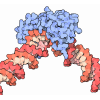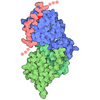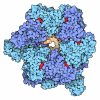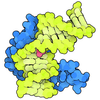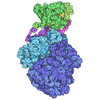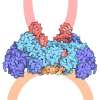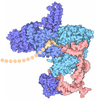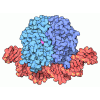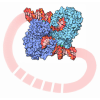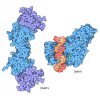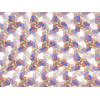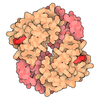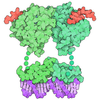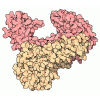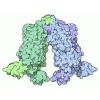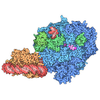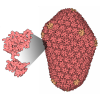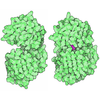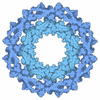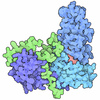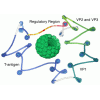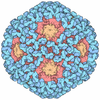[English] 日本語
 Yorodumi
Yorodumi- PDB-8ol1: cGAS-Nucleosome in complex with SPSB3-ELOBC (composite structure) -
+ Open data
Open data
- Basic information
Basic information
| Entry | Database: PDB / ID: 8ol1 | |||||||||||||||||||||||||||
|---|---|---|---|---|---|---|---|---|---|---|---|---|---|---|---|---|---|---|---|---|---|---|---|---|---|---|---|---|
| Title | cGAS-Nucleosome in complex with SPSB3-ELOBC (composite structure) | |||||||||||||||||||||||||||
 Components Components |
| |||||||||||||||||||||||||||
 Keywords Keywords | IMMUNE SYSTEM / cGAS / degradation / UPS | |||||||||||||||||||||||||||
| Function / homology |  Function and homology information Function and homology information2',3'-cyclic GMP-AMP synthase activity / cyclic GMP-AMP synthase / STING mediated induction of host immune responses / paracrine signaling / poly-ADP-D-ribose modification-dependent protein binding / target-directed miRNA degradation / elongin complex / regulation of immunoglobulin production / cGAS/STING signaling pathway / regulation of T cell activation ...2',3'-cyclic GMP-AMP synthase activity / cyclic GMP-AMP synthase / STING mediated induction of host immune responses / paracrine signaling / poly-ADP-D-ribose modification-dependent protein binding / target-directed miRNA degradation / elongin complex / regulation of immunoglobulin production / cGAS/STING signaling pathway / regulation of T cell activation / pattern recognition receptor signaling pathway / VCB complex / Cul5-RING ubiquitin ligase complex / : / negative regulation of epithelial to mesenchymal transition / SCF ubiquitin ligase complex / Cul2-RING ubiquitin ligase complex / cytoplasmic pattern recognition receptor signaling pathway / negative regulation of cGAS/STING signaling pathway / STAT family protein binding / cellular response to exogenous dsRNA / RSV-host interactions / ubiquitin-like protein ligase binding / Pausing and recovery of Tat-mediated HIV elongation / Tat-mediated HIV elongation arrest and recovery / HIV elongation arrest and recovery / Pausing and recovery of HIV elongation / positive regulation of type I interferon production / negative regulation of double-strand break repair via homologous recombination / Tat-mediated elongation of the HIV-1 transcript / : / Formation of HIV-1 elongation complex containing HIV-1 Tat / ubiquitin-like ligase-substrate adaptor activity / protein K48-linked ubiquitination / Formation of HIV elongation complex in the absence of HIV Tat / negative regulation of megakaryocyte differentiation / protein localization to CENP-A containing chromatin / nucleosome binding / Chromatin modifying enzymes / RNA Polymerase II Transcription Elongation / Replacement of protamines by nucleosomes in the male pronucleus / Formation of RNA Pol II elongation complex / CENP-A containing nucleosome / positive regulation of defense response to virus by host / Packaging Of Telomere Ends / phosphatidylinositol-4,5-bisphosphate binding / Recognition and association of DNA glycosylase with site containing an affected purine / Cleavage of the damaged purine / RNA Polymerase II Pre-transcription Events / Deposition of new CENPA-containing nucleosomes at the centromere / Recognition and association of DNA glycosylase with site containing an affected pyrimidine / Cleavage of the damaged pyrimidine / activation of innate immune response / telomere organization / Interleukin-7 signaling / RNA Polymerase I Promoter Opening / Inhibition of DNA recombination at telomere / Meiotic synapsis / Assembly of the ORC complex at the origin of replication / SUMOylation of chromatin organization proteins / Regulation of endogenous retroelements by the Human Silencing Hub (HUSH) complex / DNA methylation / Condensation of Prophase Chromosomes / Chromatin modifications during the maternal to zygotic transition (MZT) / SIRT1 negatively regulates rRNA expression / HCMV Late Events / transcription corepressor binding / ERCC6 (CSB) and EHMT2 (G9a) positively regulate rRNA expression / PRC2 methylates histones and DNA / determination of adult lifespan / Regulation of endogenous retroelements by KRAB-ZFP proteins / Defective pyroptosis / TP53 Regulates Transcription of DNA Repair Genes / HDACs deacetylate histones / transcription initiation at RNA polymerase II promoter / Regulation of endogenous retroelements by Piwi-interacting RNAs (piRNAs) / transcription elongation by RNA polymerase II / Nonhomologous End-Joining (NHEJ) / RNA Polymerase I Promoter Escape / molecular condensate scaffold activity / Transcriptional regulation by small RNAs / Vif-mediated degradation of APOBEC3G / Formation of the beta-catenin:TCF transactivating complex / Activated PKN1 stimulates transcription of AR (androgen receptor) regulated genes KLK2 and KLK3 / RUNX1 regulates genes involved in megakaryocyte differentiation and platelet function / HDMs demethylate histones / Inactivation of CSF3 (G-CSF) signaling / G2/M DNA damage checkpoint / NoRC negatively regulates rRNA expression / Oxygen-dependent proline hydroxylation of Hypoxia-inducible Factor Alpha / Evasion by RSV of host interferon responses / B-WICH complex positively regulates rRNA expression / DNA Damage/Telomere Stress Induced Senescence / PKMTs methylate histone lysines / Meiotic recombination / Pre-NOTCH Transcription and Translation / Regulation of expression of SLITs and ROBOs / Metalloprotease DUBs / RMTs methylate histone arginines / Activation of anterior HOX genes in hindbrain development during early embryogenesis Similarity search - Function | |||||||||||||||||||||||||||
| Biological species |  Homo sapiens (human) Homo sapiens (human) | |||||||||||||||||||||||||||
| Method | ELECTRON MICROSCOPY / single particle reconstruction / cryo EM / Resolution: 3.5 Å | |||||||||||||||||||||||||||
 Authors Authors | Xu, P.B. / Ablasser, A. | |||||||||||||||||||||||||||
| Funding support | European Union, 1items
| |||||||||||||||||||||||||||
 Citation Citation |  Journal: Nature / Year: 2024 Journal: Nature / Year: 2024Title: The CRL5-SPSB3 ubiquitin ligase targets nuclear cGAS for degradation. Authors: Pengbiao Xu / Ying Liu / Chong Liu / Baptiste Guey / Lingyun Li / Pauline Melenec / Jonathan Ricci / Andrea Ablasser /   Abstract: Cyclic GMP-AMP synthase (cGAS) senses aberrant DNA during infection, cancer and inflammatory disease, and initiates potent innate immune responses through the synthesis of 2'3'-cyclic GMP-AMP (cGAMP). ...Cyclic GMP-AMP synthase (cGAS) senses aberrant DNA during infection, cancer and inflammatory disease, and initiates potent innate immune responses through the synthesis of 2'3'-cyclic GMP-AMP (cGAMP). The indiscriminate activity of cGAS towards DNA demands tight regulatory mechanisms that are necessary to maintain cell and tissue homeostasis under normal conditions. Inside the cell nucleus, anchoring to nucleosomes and competition with chromatin architectural proteins jointly prohibit cGAS activation by genomic DNA. However, the fate of nuclear cGAS and its role in cell physiology remains unclear. Here we show that the ubiquitin proteasomal system (UPS) degrades nuclear cGAS in cycling cells. We identify SPSB3 as the cGAS-targeting substrate receptor that associates with the cullin-RING ubiquitin ligase 5 (CRL5) complex to ligate ubiquitin onto nuclear cGAS. A cryo-electron microscopy structure of nucleosome-bound cGAS in a complex with SPSB3 reveals a highly conserved Asn-Asn (NN) minimal degron motif at the C terminus of cGAS that directs SPSB3 recruitment, ubiquitylation and cGAS protein stability. Interference with SPSB3-regulated nuclear cGAS degradation primes cells for type I interferon signalling, conferring heightened protection against infection by DNA viruses. Our research defines protein degradation as a determinant of cGAS regulation in the nucleus and provides structural insights into an element of cGAS that is amenable to therapeutic exploitation. | |||||||||||||||||||||||||||
| History |
|
- Structure visualization
Structure visualization
| Structure viewer | Molecule:  Molmil Molmil Jmol/JSmol Jmol/JSmol |
|---|
- Downloads & links
Downloads & links
- Download
Download
| PDBx/mmCIF format |  8ol1.cif.gz 8ol1.cif.gz | 434.2 KB | Display |  PDBx/mmCIF format PDBx/mmCIF format |
|---|---|---|---|---|
| PDB format |  pdb8ol1.ent.gz pdb8ol1.ent.gz | 326.7 KB | Display |  PDB format PDB format |
| PDBx/mmJSON format |  8ol1.json.gz 8ol1.json.gz | Tree view |  PDBx/mmJSON format PDBx/mmJSON format | |
| Others |  Other downloads Other downloads |
-Validation report
| Summary document |  8ol1_validation.pdf.gz 8ol1_validation.pdf.gz | 845.1 KB | Display |  wwPDB validaton report wwPDB validaton report |
|---|---|---|---|---|
| Full document |  8ol1_full_validation.pdf.gz 8ol1_full_validation.pdf.gz | 864.2 KB | Display | |
| Data in XML |  8ol1_validation.xml.gz 8ol1_validation.xml.gz | 46.5 KB | Display | |
| Data in CIF |  8ol1_validation.cif.gz 8ol1_validation.cif.gz | 77.4 KB | Display | |
| Arichive directory |  https://data.pdbj.org/pub/pdb/validation_reports/ol/8ol1 https://data.pdbj.org/pub/pdb/validation_reports/ol/8ol1 ftp://data.pdbj.org/pub/pdb/validation_reports/ol/8ol1 ftp://data.pdbj.org/pub/pdb/validation_reports/ol/8ol1 | HTTPS FTP |
-Related structure data
| Related structure data |  16936MC  8okxC M: map data used to model this data C: citing same article ( |
|---|---|
| Similar structure data | Similarity search - Function & homology  F&H Search F&H Search |
- Links
Links
- Assembly
Assembly
| Deposited unit | 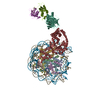
|
|---|---|
| 1 |
|
- Components
Components
-Protein , 6 types, 8 molecules AEBFKLMN
| #1: Protein | Mass: 11546.513 Da / Num. of mol.: 2 Source method: isolated from a genetically manipulated source Source: (gene. exp.)  Homo sapiens (human) Homo sapiens (human)Gene: H3C15, HIST2H3A, H3C14, H3F2, H3FM, HIST2H3C, H3C13, HIST2H3D Production host:  #2: Protein | Mass: 9180.745 Da / Num. of mol.: 2 Source method: isolated from a genetically manipulated source Source: (gene. exp.)  Homo sapiens (human) Homo sapiens (human)Gene: H4C1, H4/A, H4FA, HIST1H4A, H4C2, H4/I, H4FI, HIST1H4B, H4C3, H4/G, H4FG, HIST1H4C, H4C4, H4/B, H4FB, HIST1H4D, H4C5, H4/J, H4FJ, HIST1H4E, H4C6, H4/C, H4FC, HIST1H4F, H4C8, H4/H, H4FH, ...Gene: H4C1, H4/A, H4FA, HIST1H4A, H4C2, H4/I, H4FI, HIST1H4B, H4C3, H4/G, H4FG, HIST1H4C, H4C4, H4/B, H4FB, HIST1H4D, H4C5, H4/J, H4FJ, HIST1H4E, H4C6, H4/C, H4FC, HIST1H4F, H4C8, H4/H, H4FH, HIST1H4H, H4C9, H4/M, H4FM, HIST1H4I, H4C11, H4/E, H4FE, HIST1H4J, H4C12, H4/D, H4FD, HIST1H4K, H4C13, H4/K, H4FK, HIST1H4L, H4C14, H4/N, H4F2, H4FN, HIST2H4, HIST2H4A, H4C15, H4/O, H4FO, HIST2H4B, H4C16, H4-16, HIST4H4 Production host:  #9: Protein | | Mass: 42202.590 Da / Num. of mol.: 1 / Mutation: K285A R300A K428A Source method: isolated from a genetically manipulated source Source: (gene. exp.)  Homo sapiens (human) / Gene: CGAS, C6orf150, MB21D1 / Production host: Homo sapiens (human) / Gene: CGAS, C6orf150, MB21D1 / Production host:  #10: Protein | | Mass: 27415.240 Da / Num. of mol.: 1 Source method: isolated from a genetically manipulated source Source: (gene. exp.)  Homo sapiens (human) / Gene: SPSB3, C16orf31, SSB3 / Production host: Homo sapiens (human) / Gene: SPSB3, C16orf31, SSB3 / Production host:  #11: Protein | | Mass: 12485.135 Da / Num. of mol.: 1 Source method: isolated from a genetically manipulated source Source: (gene. exp.)  Homo sapiens (human) / Gene: ELOC, TCEB1 / Production host: Homo sapiens (human) / Gene: ELOC, TCEB1 / Production host:  #12: Protein | | Mass: 13147.781 Da / Num. of mol.: 1 Source method: isolated from a genetically manipulated source Source: (gene. exp.)  Homo sapiens (human) / Gene: ELOB, TCEB2 / Production host: Homo sapiens (human) / Gene: ELOB, TCEB2 / Production host:  |
|---|
-Histone H2A type 1- ... , 2 types, 2 molecules CG
| #3: Protein | Mass: 11763.755 Da / Num. of mol.: 1 Source method: isolated from a genetically manipulated source Source: (gene. exp.)  Homo sapiens (human) / Gene: H2AC12, HIST1H2AH, HIST1H2AI / Production host: Homo sapiens (human) / Gene: H2AC12, HIST1H2AH, HIST1H2AI / Production host:  |
|---|---|
| #5: Protein | Mass: 11666.640 Da / Num. of mol.: 1 Source method: isolated from a genetically manipulated source Source: (gene. exp.)  Homo sapiens (human) / Gene: H2AC14, H2AFE, HIST1H2AJ / Production host: Homo sapiens (human) / Gene: H2AC14, H2AFE, HIST1H2AJ / Production host:  |
-Histone H2B type 1- ... , 2 types, 2 molecules DH
| #4: Protein | Mass: 10623.174 Da / Num. of mol.: 1 Source method: isolated from a genetically manipulated source Source: (gene. exp.)  Homo sapiens (human) / Gene: H2BC9, H2BFJ, HIST1H2BH / Production host: Homo sapiens (human) / Gene: H2BC9, H2BFJ, HIST1H2BH / Production host:  |
|---|---|
| #6: Protein | Mass: 10493.994 Da / Num. of mol.: 1 Source method: isolated from a genetically manipulated source Source: (gene. exp.)  Homo sapiens (human) / Gene: H2BC15, H2BFD, HIST1H2BN / Production host: Homo sapiens (human) / Gene: H2BC15, H2BFD, HIST1H2BN / Production host:  |
-DNA chain , 2 types, 2 molecules IJ
| #7: DNA chain | Mass: 44552.379 Da / Num. of mol.: 1 / Source method: obtained synthetically / Source: (synth.)  Homo sapiens (human) Homo sapiens (human) |
|---|---|
| #8: DNA chain | Mass: 44961.633 Da / Num. of mol.: 1 / Source method: obtained synthetically / Source: (synth.)  Homo sapiens (human) Homo sapiens (human) |
-Non-polymers , 1 types, 1 molecules 
| #13: Chemical | ChemComp-ZN / |
|---|
-Details
| Has ligand of interest | Y |
|---|---|
| Has protein modification | N |
-Experimental details
-Experiment
| Experiment | Method: ELECTRON MICROSCOPY |
|---|---|
| EM experiment | Aggregation state: PARTICLE / 3D reconstruction method: single particle reconstruction |
- Sample preparation
Sample preparation
| Component | Name: cGAS-Spsb3-EloBC complex / Type: COMPLEX / Entity ID: #1-#4 / Source: RECOMBINANT |
|---|---|
| Source (natural) | Organism:  Homo sapiens (human) Homo sapiens (human) |
| Source (recombinant) | Organism:  |
| Buffer solution | pH: 7.4 / Details: PBS buffer |
| Specimen | Embedding applied: NO / Shadowing applied: NO / Staining applied: NO / Vitrification applied: YES |
| Vitrification | Cryogen name: ETHANE |
- Electron microscopy imaging
Electron microscopy imaging
| Experimental equipment |  Model: Titan Krios / Image courtesy: FEI Company |
|---|---|
| Microscopy | Model: FEI TITAN KRIOS |
| Electron gun | Electron source:  FIELD EMISSION GUN / Accelerating voltage: 300 kV / Illumination mode: FLOOD BEAM FIELD EMISSION GUN / Accelerating voltage: 300 kV / Illumination mode: FLOOD BEAM |
| Electron lens | Mode: BRIGHT FIELD / Nominal defocus max: 2000 nm / Nominal defocus min: 600 nm |
| Image recording | Electron dose: 40 e/Å2 / Film or detector model: FEI FALCON IV (4k x 4k) |
- Processing
Processing
| Software | Name: PHENIX / Version: 1.20rc2_4400: / Classification: refinement | ||||||||||||||||||||||||
|---|---|---|---|---|---|---|---|---|---|---|---|---|---|---|---|---|---|---|---|---|---|---|---|---|---|
| EM software | Name: PHENIX / Category: model refinement | ||||||||||||||||||||||||
| CTF correction | Type: NONE | ||||||||||||||||||||||||
| 3D reconstruction | Resolution: 3.5 Å / Resolution method: FSC 0.143 CUT-OFF / Num. of particles: 592494 / Symmetry type: POINT | ||||||||||||||||||||||||
| Refine LS restraints |
|
 Movie
Movie Controller
Controller


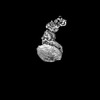


 PDBj
PDBj